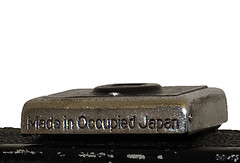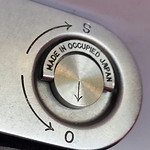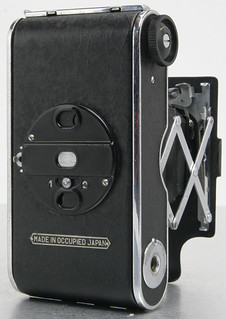Difference between revisions of "Made in Occupied Japan"
(→Sources: pic) |
Hanskerensky (talk | contribs) m (→Links) |
||
| (5 intermediate revisions by 3 users not shown) | |||
| Line 6: | Line 6: | ||
|image_by= Dirk HR Spennemann | |image_by= Dirk HR Spennemann | ||
| image_rights=with permission | | image_rights=with permission | ||
| − | }} | + | }}{{Flickr_image |
| + | |image_source= https://www.flickr.com/photos/thorpehamlet/14025161669/in/pool-camerawiki/ | ||
| + | |image= http://farm3.staticflickr.com/2915/14025161669_0dea542dc2_m.jpg | ||
| + | |image_align= left | ||
| + | |image_text= collapsed finder of [[Semi Leotax]] | ||
| + | |image_by= John-Henry Collinson | ||
| + | |image_rights= wp | ||
| + | }}{{brl}} | ||
| + | |||
A number of Japanese cameras are marked "Made in Occupied Japan" (often abbreviated MIOJ). | A number of Japanese cameras are marked "Made in Occupied Japan" (often abbreviated MIOJ). | ||
On February 20, 1947 the Supreme Commander for the Allied Powers (SCAP) in Japan issued the instruction SCAPIN 1535, stating that all export items must be identified with an engraving “'''Made in Occupied Japan'''". This decree was repealed on December 5, 1949 through SCAPIN 2061. Many camera manufacturers continued to use the "Made in Occupied Japan" markings until 1951, even though they could have substituted it with "Made in Japan". The latter became standard once the U.S. occupation of Japan formally ended in 1952. | On February 20, 1947 the Supreme Commander for the Allied Powers (SCAP) in Japan issued the instruction SCAPIN 1535, stating that all export items must be identified with an engraving “'''Made in Occupied Japan'''". This decree was repealed on December 5, 1949 through SCAPIN 2061. Many camera manufacturers continued to use the "Made in Occupied Japan" markings until 1951, even though they could have substituted it with "Made in Japan". The latter became standard once the U.S. occupation of Japan formally ended in 1952. | ||
| + | |||
| + | == Sources == | ||
| + | {{brr}} | ||
| + | |||
| + | {{Flickr_image | ||
| + | |image_source= http://www.flickr.com/photos/90900361@N08/27620184832/in/pool-camerawiki/ | ||
| + | |image= http://farm8.staticflickr.com/7416/27620184832_d534cc6fdd_q.jpg | ||
| + | |image_align= right | ||
| + | |image_text= stamp in a Minolta-35 case | ||
| + | |image_by= Geoff Harrisson | ||
| + | |image_rights= wp | ||
| + | }} | ||
{{Flickr_image | {{Flickr_image | ||
| − | |image_source= http://www.flickr.com/photos/90900361@N08/8328762732 | + | |image_source= http://www.flickr.com/photos/90900361@N08/8328762732/in/pool-camerawiki/ |
| − | |image= http://farm9.staticflickr.com/8357/ | + | |image= http://farm9.staticflickr.com/8357/8328762732_2152896440_q.jpg |
| − | |image_align= | + | |image_align= right |
|image_text= [[Minolta-35]] baseplate engraving | |image_text= [[Minolta-35]] baseplate engraving | ||
|image_by= Geoff Harrisson | |image_by= Geoff Harrisson | ||
| Line 20: | Line 40: | ||
}} | }} | ||
| − | |||
| − | |||
{{Flickr_image | {{Flickr_image | ||
| − | |image_source= | + | |image_source= http://www.flickr.com/photos/90900361@N08/27895750472/in/pool-camerawiki/ |
| − | |image= http:// | + | |image= http://farm8.staticflickr.com/7413/27895750472_7d0bdf5051_q.jpg |
|image_align= right | |image_align= right | ||
| − | |image_text= | + | |image_text= on a Nicca Type 3 <br><small>image by eBayer uwin2</small> |
| − | |image_by= | + | |image_by= |
|image_rights= wp | |image_rights= wp | ||
}} | }} | ||
| Line 38: | Line 56: | ||
: | : | ||
: | : | ||
| + | {{brr}} | ||
| + | {{Flickr_image | ||
| + | |image_source= https://www.flickr.com/photos/camerawiki/47058476191/in/pool-camerawiki | ||
| + | |image= https://live.staticflickr.com/7828/47058476191_b05d975b2b_n.jpg | ||
| + | |image_align= right | ||
| + | |image_text= <small>[[Pearlette]], 1940 model, Optor f/6.3 lens,<br>"Made in Occupied Japan". Sample of a pre-war<br>camera model that was produdced again after<br>the 2nd World War.</small> | ||
| + | |image_by= rebollo_fr | ||
| + | |image_rights= wp | ||
| + | }} | ||
| + | |||
:Dec 5, 1949: SCAPIN 2061 | :Dec 5, 1949: SCAPIN 2061 | ||
:Subject: Marking of export articles [excerpt]. | :Subject: Marking of export articles [excerpt]. | ||
| Line 47: | Line 75: | ||
==Links== | ==Links== | ||
*Discussions regarding MOJ labelling on [http://nikonhistoricalsociety.yuku.com/topic/424/t/MIOJ-engravings-from-1947-till-1949-1952.html| Nikon cameras] | *Discussions regarding MOJ labelling on [http://nikonhistoricalsociety.yuku.com/topic/424/t/MIOJ-engravings-from-1947-till-1949-1952.html| Nikon cameras] | ||
| − | *Discussions regarding MOJ labelling on [ | + | *Discussions regarding MOJ labelling on [https://www.rangefinderforum.com/node/44355 Canon cameras] |
[[Category: Japan]] | [[Category: Japan]] | ||
Latest revision as of 07:40, 22 February 2022

|
| Konica I with "Made in occupied Japan" engraving image by Dirk HR Spennemann (Image rights) |

|
| collapsed finder of Semi Leotax image by John-Henry Collinson (Image rights) |
A number of Japanese cameras are marked "Made in Occupied Japan" (often abbreviated MIOJ).
On February 20, 1947 the Supreme Commander for the Allied Powers (SCAP) in Japan issued the instruction SCAPIN 1535, stating that all export items must be identified with an engraving “Made in Occupied Japan". This decree was repealed on December 5, 1949 through SCAPIN 2061. Many camera manufacturers continued to use the "Made in Occupied Japan" markings until 1951, even though they could have substituted it with "Made in Japan". The latter became standard once the U.S. occupation of Japan formally ended in 1952.
Sources

|
| stamp in a Minolta-35 case image by Geoff Harrisson (Image rights) |

|
| Minolta-35 baseplate engraving image by Geoff Harrisson (Image rights) |

|
| on a Nicca Type 3 image by eBayer uwin2 (Image rights) |
- Feb 20, 1947: SCAPIN 1535
- Subject: Marking of export articles [excerpt].
- The Imperial Japanese Government is hereby directed to take immediate steps to insure that every article prepared for export after 15 days of receipt of this directive will be marked, stamped, branded or labeled in legible English with the words ”Made in occupied Japan”.
- [Signed:] For the Supreme Commander, John B. Cooley, Colonel AGD. :(Nippon Times (Directives) 1947).[1]

|
| Pearlette, 1940 model, Optor f/6.3 lens, "Made in Occupied Japan". Sample of a pre-war camera model that was produdced again after the 2nd World War. image by rebollo_fr (Image rights) |
- Dec 5, 1949: SCAPIN 2061
- Subject: Marking of export articles [excerpt].
- Rescinds SCAPIN 1535. Except as specified, all articles prepared for export, the immediate container thereof and the outside package will be marked, branded or labelled in legible English with the words 'Made in Occupied Japan," 'Made in Japan" or "Japan." [2]
Notes
- ↑ Source: Bertrand M. Roehner Some Examples of SCAPINS (SCAP Instructions to the Japanese Government) 1 September 1945–31 March 1952.
- ↑ Finding aid to National Archives and Record Administration (Washington, DC) Record Group 331 "Supreme Commander for the Allied Poers Directives to the Japanese Government (SCAPINs)."
Links
- Discussions regarding MOJ labelling on Nikon cameras
- Discussions regarding MOJ labelling on Canon cameras